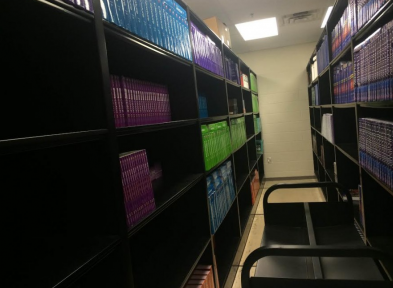A change in Texas textbooks

The State Board of Education has approved new social studies textbooks for the 2015-16 school year. The new books were passed by a 10-5 vote with all 10 Republicans voting for the new textbooks and all five Democrats voting against the new textbooks.
December 10, 2014
New guidelines for 89 Texas social studies textbooks have been approved that will change the much-disputed U.S. history textbook content for the first time since 2002. The adoption of the new textbooks and online books has been a source of controversy in recent weeks, but final decisions by the State Board of Education (SBOE) made in late November indicate a lean towards a more conservative take on U.S. history.
According to social studies curriculum coordinator Bev Smith, who was involved in a state committee on the previous textbook adoption, the processes in both the districts and on at the the SBOE are thorough.
“That is a very long and drawn out process, you get a lot of people involved in that process, and you get a lot of different ideas about how social studies should be taught,” Smith said. “There can be quite a few disagreements, but eventually you reach a compromise. You have to figure out which books cover which percentage of the texts.”
The decision will take effect in the fall of 2015, when social studies students will be receiving textbooks with new material. While Texas school districts are not required to purchase from the list of the 89 proposed textbooks, most school districts usually do so.
“The way we choose the books is we look at: is the information either written on grade level or above grade level? Does it present the information in a upper-level way? Does it have different materials we can use, videos, online resources as well?” AP World History teacher Kevin Finn said. “That’s really what we’re looking for.”
The adoption includes new online options, which is an aspect that many teachers look forward to exploring.
“They’re offering the physical book, they’re offering online materials, and that’s what I’m particularly interested in,” Smith said. “I want to see if a student can access their textbook at any time from anywhere and anyplace. I want to get the biggest bang for our buck. It’s very intricate in trying to figure out who has what, and what package they have that would best serve the needs of the students and teachers in the district.”
E-books and other software packages have the potential to improve classroom flexibility.
“Since we didn’t have textbooks for the first six weeks, it would be good to have online resources, and my students would love to have online resources as well,” Finn said. “It’s something that we can all use, I think it’s a good thing to use. It would change the way classes are done, but I think it’s a better way to have it if every student has access to online at home.”
In addition to changes in medium, some controversy has stemmed from the apparent conservative direction of the textbooks. Specifically, Board members debated the importance of the biblical figure Moses in the founding of the U.S., the inclusion of global warming, and some concerns over the negative portrayal of Muslims.
“I give both sides to [the issues],” Smith said. “My students know, here’s one perspective on climate change, here’s others. Our goal is awareness, just basic fundamental knowledge of these religions, because they are part of the global culture of our planet. The danger here is, we’re here to educate, not indoctrinate. To indoctrinate as an educator is ethically wrong.”
Attributed to the controversies and to a need to accommodate the new standards, six e-books from the publisher WorldView were rejected by the Board. In addition, the commonly used publisher Houghton Mifflin Harcourt withdrew its U.S. history textbook, which is accepted in other states, as it did not meet Texas’ textbook adoption requirements.
“I like textbook adoption processes like that, because we have them so we can talk about them, and we can kind of hash that stuff out,” AP U.S. History teacher Brian Erskine said. “So yes, it’s kind of messy, but making sausages is always messy. Nobody wants to see the process behind it, but what comes out of it is a really good thing.”
The concerns and disputes are a part of an effort to produce a list of textbooks or classroom tools that relay information correctly.
“I think that there’s a propensity to be moving towards more progressive globalism type textbooks in social studies, and that’s dangerous for U.S. History,” Erskine said. “Because we’ve got to be focusing on teaching history the way it happened, and not in the way that we wished it had happened. I just hope that when they make their final decisions in each textbook adoption, that their primary concern is how accurate the information is.”
Controversy aside, the shift towards the online aspect component of the adoption will create a more updated social studies curriculum.
“The [existing] world geography books are 12 years old,” Smith said. “They may have changed a map or two to be current with today, but I didn’t see any different content. The good thing about having them online is that if the TEKS change in two years, which they probably will because of the controversy, there will be the opportunity for publishers to go in and make those changes electronically so that those books are up to date. So those books won’t be outdated in 2 years.”
While the controversial process of textbook approval may have caused disputes in Texas education, students and teachers are likely to notice changes in social studies in the fall in regards to electronic classroom tools and textbook content.
“You give all perspectives and you give people the opportunity to make decisions on what’s right based on what they know,” Smith said. “It’s not an easy process, but we take that challenge on for our students, and so that teachers have all the necessary materials to provide the best possible education for every child in their classroom. And that’s the best you can hope for.”



